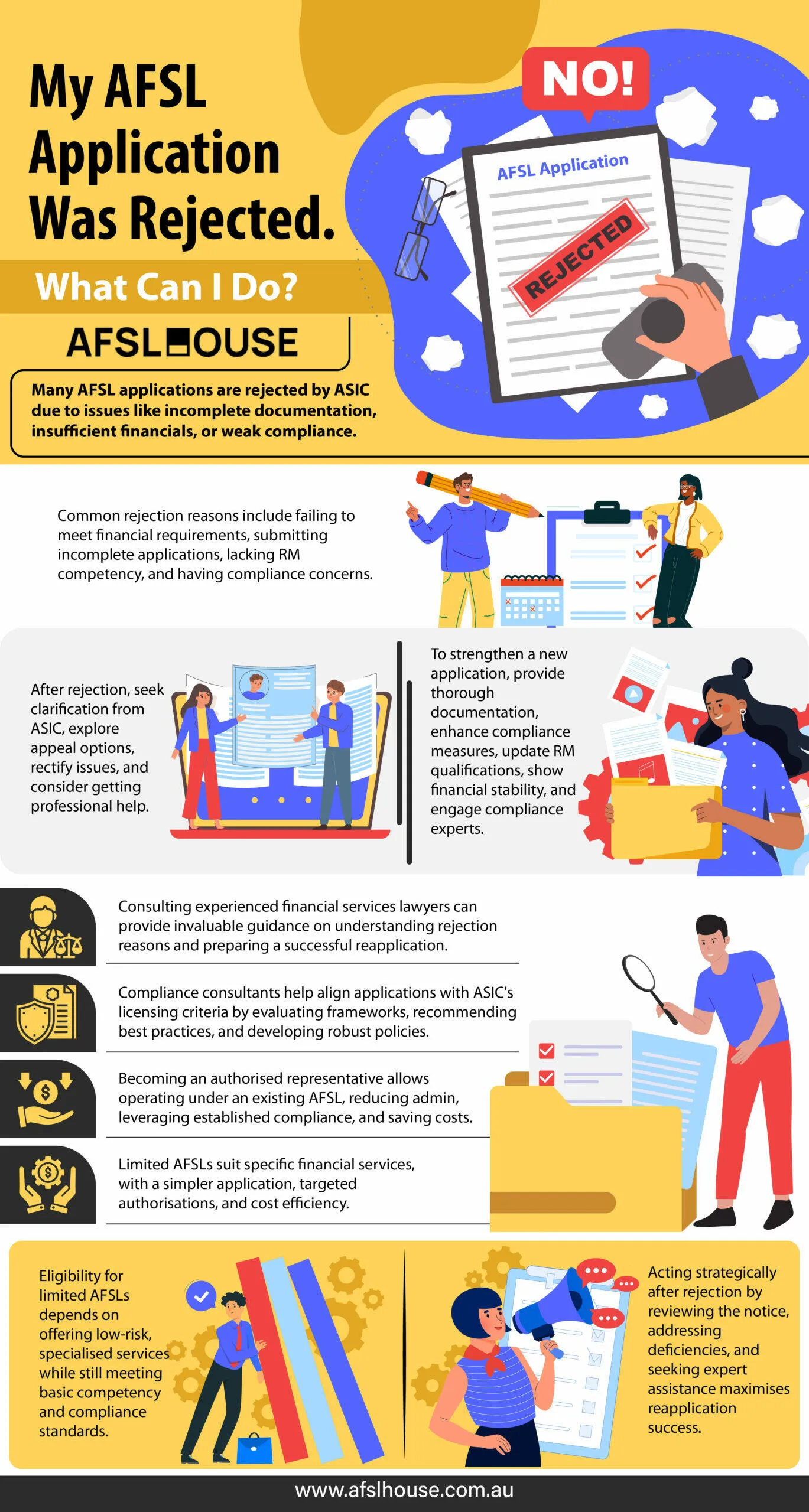Introduction
Obtaining an Australian Financial Services Licence (AFSL) is essential for businesses operating in Australia’s financial sector. This licence confirms that financial service providers meet the required expertise, compliance, and operational standards, ensuring consumer protection and industry integrity.
However, despite careful preparation, many AFSL applications are rejected by the Australian Securities and Investments Commission (ASIC) due to incomplete documentation, inadequate financial resources, or weak compliance frameworks. Understanding these common pitfalls is crucial for applicants seeking to strengthen their submission and increase their chances of approval upon reapplication.

Get Your Free Initial Consultation
Consult with one of our experienced ACL & AFSL Lawyers today.
Reasons for Rejection of Your AFS Licence Application
Failure to Meet Financial Requirements
Applicants must demonstrate that they have sufficient financial resources to operate their proposed financial services business, which is one of the core financial requirement obligations. This includes proving solvency, maintaining positive net assets, and having adequate financial documentation to support their application. Insufficient financial resources or inadequate financial statements can lead to rejection.
Incomplete or Inaccurate Application
Submitting a complete and accurate application, which includes all the essential documents for an AFSL application, is crucial for approval. Under the current system, common errors that result in rejection include failing to fully complete the online transaction in the ASIC Regulatory Portal, providing incorrect or outdated information, or missing required People Proofs.
The new online application consolidates what was previously submitted across multiple forms and core proof documents, so ensuring every section is thoroughly completed and all information is accurate can significantly improve the chances of acceptance.
Lack of Competency or Qualifications
ASIC scrutinises the competency and qualifications of responsible managers (RMs) to ensure they meet the necessary standards for the financial services and products being offered. Deficiencies in qualifications, which can often be addressed with responsible manager training, lack of relevant experience, or inability to demonstrate the required knowledge can lead to application rejection. RMs must possess the appropriate expertise and certifications relevant to their roles.
Concerns About Compliance and Risk Management
Inadequate compliance arrangements and poor risk management practices are significant factors that can cause ASIC to reject an application. Applicants must demonstrate robust systems and processes to manage compliance obligations and mitigate risks effectively. Failure to provide evidence of comprehensive compliance and risk management strategies can result in the refusal of the licence application.
Speak with an ACL & AFSL Lawyer Today
Request a Consultation to Get Started.
Steps to Take After Rejection
Seeking Clarification from ASIC
After receiving a rejection notice for your AFSL application, it is crucial to contact ASIC to obtain a detailed explanation of the reasons behind the decision. Understanding these reasons will help you identify whether the rejection was due to incomplete documentation, failure to meet specific requirements, or concerns about competency and compliance.
Exploring Appeal Options
Once you have clarified the reasons for rejection, you can explore the following appeal options:
- Internal Review: Apply for an internal review of ASIC’s decision within the 28-day window provided. This process allows ASIC to assess your application again based on any additional information or corrections you provide.
- Administrative Appeals Tribunal (AAT): If you are dissatisfied with the outcome of the internal review, you have the option to escalate your case to the AAT for an independent evaluation.
- Rectifying and Reapplying: Address the deficiencies identified in your initial application by correcting errors, providing additional documentation, and strengthening your compliance measures before submitting a new application.
- Seeking Professional Assistance: Consulting a financial services lawyer or compliance consultant can provide expert guidance on improving your application and navigating the appeals process effectively.
Get Your Free Initial Consultation
Consult with one of our experienced ACL & AFSL Lawyers today.
Rectifying Issues and Reapplying
Correcting Errors in Your Application
When your AFSL application is rejected, addressing the specific errors is essential for a successful reapplication. This involves correcting information directly within the online application on the ASIC Regulatory Portal, rather than amending separate forms and documents as was required under the previous system.
- Review the Rejection Notice: Carefully examine ASIC’s reasons for rejection to identify the exact deficiencies in the information you provided.
- Update and Complete Information: Ensure all questions in the online application are answered accurately, and that all required People Proofs are complete, current, and correctly uploaded.
- Ensure Accuracy and Compliance: Double-check that all information is correct and complies with ASIC’s regulatory guidelines.
- Seek Professional Assistance: Consulting a compliance consultant or financial services lawyer can help identify and rectify any remaining issues in your application.
Strengthening Your New Application
To improve the chances of approval for your new AFSL application, consider the following strategies:
- Provide Comprehensive Information: Submit a thorough online application that fully demonstrates your capacity to comply with licensing requirements, including enhanced compliance policies.
- Enhance Compliance Measures: Strengthen your risk management and compliance arrangements by implementing robust systems and processes to ensure your financial services business operates efficiently, honestly, and fairly.
- Update RM People Proofs: Ensure that your RMs possess the necessary qualifications and experience. Provide a complete and current set of People Proofs, including qualification certificates and up-to-date criminal history and bankruptcy checks, to satisfy ASIC’s fit and proper person requirements.
- Demonstrate Financial Stability: Be prepared to present clear and accurate financial statements to ASIC at the ‘requirements stage’ that showcase your business’s financial health and ability to sustain operations.
- Engage a Compliance Professional: Working with a compliance consultant or legal advisor can help you present a well-structured and compliant application, ensuring alignment with ASIC’s licensing criteria.
Speak with an ACL & AFSL Lawyer Today
Request a Consultation to Get Started.
Seeking Professional Assistance
Consulting a Financial Services Lawyer
Engaging a financial services lawyer can provide invaluable support after your AFSL application has been rejected. A lawyer can help you understand the specific reasons for rejection, ensuring you fully grasp the deficiencies in your original application.
They can also assist in preparing appeals or resubmissions, drafting necessary documentation, and ensuring that your reapplication is thorough and complies with all legal requirements. Additionally, a lawyer can navigate the complexities of ASIC’s regulatory framework, helping you to present a stronger case and increase the likelihood of a successful outcome.
Engaging a Compliance Consultant
A compliance consultant plays a crucial role in aligning your AFSL application with ASIC’s stringent licensing criteria. They can conduct AFSL audits to evaluate your current compliance frameworks and identify areas that need improvement to meet regulatory standards.
By providing expert guidance on best practices for risk management, financial reporting, and organisational competence, compliance consultants help ensure that your application fulfils all requirements. Furthermore, they can assist in developing comprehensive compliance policies and procedures, which strengthen your licence application and support ongoing adherence to ASIC’s obligations once your licence is granted.
Get Your Free Initial Consultation
Consult with one of our experienced ACL & AFSL Lawyers today.
Alternative Licensing Options
Becoming an Authorised Representative
Becoming an authorised representative in Australia allows you to operate under an existing AFSL holder, eliminating the need to obtain a full AFSL independently. This arrangement offers several benefits:
- Reduced Administrative Burden: By associating with a licensed entity, you bypass the extensive application process required for a full licence, saving time and resources.
- Access to Established Compliance Systems: Leveraging the parent company’s compliance frameworks ensures that you meet regulatory standards without having to develop these systems from scratch.
- Cost-Effective Solution: Operating as an Authorised Representative can be more affordable, as it eliminates the need for separate licence fees and related costs.
To become an Authorised Representative, you typically need to agree with an existing AFSL holder who will oversee your operations and ensure compliance with regulatory obligations. This partnership allows you to focus on delivering financial services while relying on the established infrastructure of the principal licence holder.
Applying for a Limited AFSL
A limited AFSL is ideal for individuals or businesses that provide specific types of financial services and do not require the comprehensive range of authorisations offered by a standard AFSL. Key advantages include:
- Simplified Application Process: The criteria and requirements for a Limited AFSL are less stringent, making it easier and quicker to obtain compared to a full licence.
- Targeted Authorisations: This licence allows you to focus on particular financial services, reducing the complexity and scope of compliance needs. For example, if you only provide financial product advice, a Limited AFSL can cover that specific service without the broader obligations of a full licence.
- Cost Efficiency: Applying for a limited licence generally incurs lower fees, making it a more cost-effective option for businesses with specific financial service offerings.
Eligibility for a limited AFSL typically depends on the scope of financial services you intend to offer and the absence of high-risk activities. Applicants must still demonstrate basic competency and compliance standards, ensuring they can meet the regulatory requirements pertinent to their specialised services.
Conclusion
After your AFSL application has been rejected, taking immediate and strategic action is essential for a successful reapplication. Begin by thoroughly reviewing the rejection notice to understand the specific reasons for the refusal, and seek clarification from ASIC if needed. Whether you choose an internal review, an appeal to the AAT, or to reapply, addressing the identified deficiencies is paramount.
To effectively navigate the reapplication process on the ASIC Regulatory Portal and ensure full compliance, consider consulting our experienced AFSL application lawyers. Our proven solutions and specialised expertise can guide you through strengthening your online application and addressing any issues promptly. Contact us today to take the next step towards securing your AFSL and advancing your financial services business with confidence.
Frequently Asked Questions
The first step is to carefully review the rejection notice from the Australian Securities and Investments Commission (ASIC) to understand the specific reasons for the refusal. This will help you identify the areas that need improvement or correction in your application.
You have 28 days from the date of the rejection notice to request an internal review of ASIC’s decision. It is important to act within this timeframe to ensure your appeal is considered.
Yes, you can reapply for an AFSL after addressing the deficiencies highlighted in the rejection notice. Strengthening your application by correcting errors and providing additional documentation will enhance your chances of approval in the new submission.
While not mandatory, seeking legal or professional assistance can greatly improve your chances of a successful reapplication. A financial services lawyer or compliance consultant can help you navigate the appeals process and ensure your application meets all regulatory requirements.
If your AFSL application is rejected, consider alternative licensing options, such as becoming an Authorised Representative of an existing AFSL holder or applying for a Limited AFSL. These alternatives allow you to operate within the financial services sector without holding a full AFSL independently.
To rectify deficiencies, review the rejection notice and address each highlighted issue. This may involve providing additional documentation, clarifying information, or enhancing your compliance measures to meet ASIC’s licensing criteria.
Common mistakes include submitting an incomplete online application through the ASIC Regulatory Portal, failing to upload a full and current set of People Proofs, providing unclear descriptions of your intended services, and not adequately demonstrating the competence of your responsible managers (RMs).
You must ensure your RMs’ qualifications and experience align with the authorisations you are seeking and provide a complete set of their People Proofs, including up-to-date criminal, bankruptcy, and qualification checks. You must also thoroughly detail their competence and skills against each required authorisation directly within the online application form.
Available resources include ASIC’s official website, which provides regulatory guides and application forms. Additionally, professional associations and compliance consultants offer support and information to assist you in preparing a successful reapplication.









